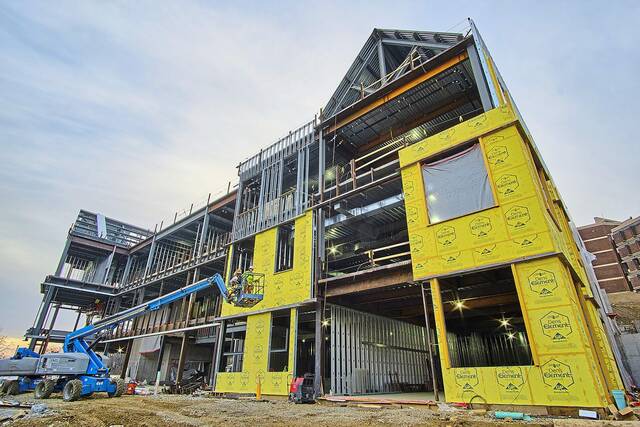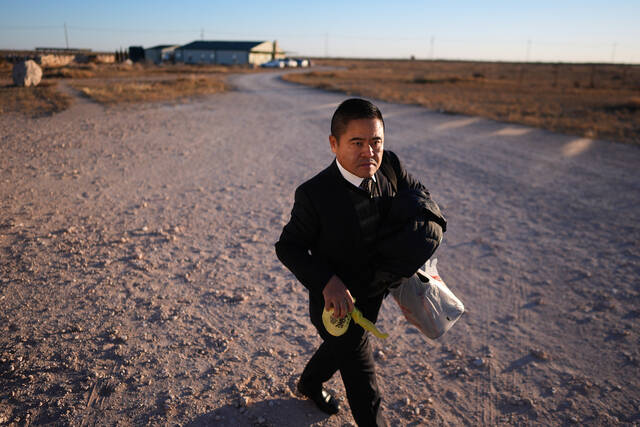The timing seemed right in November 2019 when the Community College of Allegheny County announced an ambitious workforce development initiative that included building a multi-story academic hall and expanding programming to steer more students into high-demand fields.
The areas of study slated for the new Workforce Development and Training Center were hot — robotics, cyber security, information technology, culinary arts and others. Construction funding largely was in place.
Then, four months before a planned June 2020 groundbreaking, the pandemic hit. It shuttered area campuses and pushed back construction schedules as the supply chain slowed.
But now, with construction well underway, the $65 million initiative is moving toward what its planners hope will be a soft opening on the North Side campus this fall and regular classroom use next spring.
CCAC President Quintin Bullock and others said the school and its students stand to benefit from a job market as robust as it was before covid-19 hit.
Workplace trends “indicate enrollment will continue to rise in these key areas,” Bullock said.
The $40 million, three-story center with 60,000 square feet of learning space is rising along Ridge Avenue. In addition, another $20 million investment is being made to upgrade workforce development capacity across CCAC’s campuses, as well as $5 million more for new college-wide programming.
Chalfant Hall, a mansion on the western edge of the North Side campus, is being renovated into a new teacher resource center to advance classroom curriculum and pedagogy.
A goal of the new center is to more fully integrate the workforce and for-credit sides of CCAC, since both kinds of instruction play a part in career success. Many students can get a foothold in high-paying fields with certification rather than an academic degree, though they ultimately may want to pursue a full degree and even more credentials to boost their earnings.
“I want to get people into their careers as soon as possible, but at the same time, I want to give them a pathway to move up in those careers,” said Michael Rinsem, who is spearheading the center’s development and holds a CCAC Endowed Professorship in Technical Curriculum.
Fred Thieman, then chair of CCAC’s board of trustees, told a news conference in November 2019 that Pioneering Pittsburgh’s Workforce Campaign was already the most ambitious capital campaign since the college’s founding in 1966. Its initial $65 million campaign goal has now been surpassed, though fundraising is continuing and a final total has not been announced.
The state is contributing $20 million toward a $40 million bond issue for the project. In addition, CCAC so far has raised more than $31 million in private donations from corporations, foundations and individuals, said CCAC spokeswoman Elizabeth Johnston.
The new development will join others nearby that are gradually changing the face of Ridge Avenue, which runs through the heart of campus. Other developments include the K. Leroy Irvis Science Center and a bookstore whose large front windows face out toward the street.
To better predict workforce demand and how best to use the new center, project planners studied data from the Labor Department and information from employers and the Allegheny Conference for Community Development.
The disparity across the Pittsburgh region’s job market was evident last decade, before the center was conceived. It was referenced in the Inflection Point report prepared by groups including the Allegheny Conference.
“There is a concentration of high-wage, high-skill occupations with relatively low unemployment such as information technology and engineering,” the report’s executive summary said. “However, there are also 32,000 long-term unemployed residents, most commonly in occupations such as production or administrative support with slower than average growth prospects.”
The report said the region needs to continue expanding innovation and growth of high-skill roles, and also “needs to redouble its efforts to address the skill and workforce needs of residents who are not currently on pathways to high-wage jobs.”
When CCAC’s initiative was announced, Bullock and other officials predicted a center with an enrollment of 1,500. Officials say the market as it is today should be able to bring in that kind of enrollment.
“The uptick we are seeing in a number of skilled trades, trades apprenticeships, health care, information technologies, advanced manufacturing and short-term and noncredit programming enrollment mirrors national and regional forecasting models,” said Bullock. “Enrollment will continue to rise in these key areas.”








